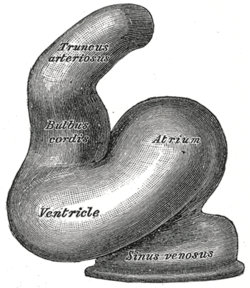

| Truncus arteriosus | |
|---|---|

Heart of human embryo of about twenty-four days. (Truncus arteriosus visible at top.)
| |

Diagrams to illustrate the transformation of the bulbus cordis. Ao. Truncus arteriosus. Au. Atrium. B. Bulbus cordis. RV. Right ventricle. LV. Left ventricle. P. Pulmonary artery.
| |
| Details | |
| Precursor | Cardiogenic area |
| Gives rise to | Aorta, pulmonary artery |
| System | Cardiovascular system |
| Identifiers | |
| MeSH | D014338 |
| TE | arteriosus_by_E5.11.1.8.1.0.4 E5.11.1.8.1.0.4 |
| FMA | 70301 |
| Anatomical terminology | |
The truncus arteriosus is a structure that is present during embryonic development.[clarification needed] It is an arterial trunk that originates from both ventricles of the heart that later divides into the aorta and the pulmonary trunk.[1]
The truncus arteriosus and bulbus cordis are divided by the aorticopulmonary septum. The truncus arteriosus gives rise to the ascending aorta and the pulmonary trunk. The caudal end of the bulbus cordis gives rise to the smooth parts (outflow tract) of the left and right ventricles (aortic vestibule & conus arteriosus respectively).[2] The cranial end of the bulbus cordis (also known as the conus cordis) gives rise to the aorta and pulmonary trunk with the truncus arteriosus.
This makes its appearance in three portions.
Failure of the truncus arteriosus to close results in the condition known as persistent truncus arteriosus, a rare congenital heart defect. This is often just referred to as truncus arteriosus. Echocardiography is used to diagnose this condition.[4][5][6] Other pathologies of the truncus arteriosus include transposition of the great vessels (arteries in this case), and tetralogy of Fallot.[7]
![]() This article incorporates text in the public domain from page 514 of the 20th edition of Gray's Anatomy (1918)
This article incorporates text in the public domain from page 514 of the 20th edition of Gray's Anatomy (1918)
|
Development of the circulatory system
| |||||||||
|---|---|---|---|---|---|---|---|---|---|
| Heart |
| ||||||||
| Vessels |
| ||||||||
| Extraembryonic hemangiogenesis |
| ||||||||
| Fetal circulation |
| ||||||||